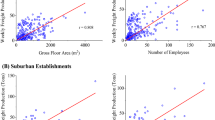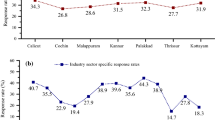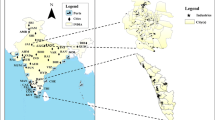Abstract
In this paper, regional freight generation models are developed for twenty industry sectors in a region comprising 101 districts of India using secondary data. We provide insights into investigating spatial dependencies, identifying the type of spatial interactions present, and adopting appropriate spatial models. Non-spatial and spatial regression models are developed, addressing different spatial interactions. The roles of economic, locational, geographical, and transportation infrastructure variables in estimating freight production and addressing spatial autocorrelation are explored. Sectoral employment, an economic variable, is found significant in estimating freight production of 20 sectors considered. Locational, geographical, and transportation infrastructure variables helped to address spatial autocorrelation for some sectors. Spatial analysis showed correlated effects and endogenous spatial interactions with global spillover feedback, suggesting that spatial error and spatial lag models are appropriate. The study framework can help researchers and planners in correcting for spatial autocorrelation while modelling freight generation. The study forms a paradigm of freight generation modelling with the available secondary data in the absence of comprehensive freight databases and systematic modelling frameworks.



Similar content being viewed by others
References
Akaike, H.: A new look at the statistical model identification. IEEE Trans. Autom. Control 19(6), 716–723 (1974)
Al-deek, H.M.: Which method is better for developing freight planning models at seaports–neural networks or multiple regression? Transp. Res. Record: J. Transp. Res. Board 1763(01), 90–97 (2001)
Al Hajj Hassan, L., Mahmassani, H.S., Chen, Y.: Reinforcement learning framework for freight demand forecasting to support operational planning decisions. Transp. Res. Part E Logist. Transp. Rev. 137, 101926 (2020). https://doi.org/10.1016/j.tre.2020.101926
Anselin, L., Rey, S.: Properties of tests for spatial dependence in linear regression models. Geogr. Anal. 23(2), 112–131 (1991)
Anselin, L., Bera, A.K., Florax, R., Yoon, M.J.: Simple diagnostic tests for spatial dependence. Reg. Sci. Urban Econ. 26(1), 77–104 (1996). https://doi.org/10.1016/0166-0462(95)02111-6
Anselin, L., Bera, A.: Spatial dependence in linear regression models with an introduction to spatial econometrics. Handbook of Applied Economic Studies, pp. 237–289. (1998)
Anselin, L., Florax, R.J.G.M.: Small sample properties of tests for spatial dependence in regression models: some further results. In: New Directions in Spatial Econ, pp. 21–74. Springer, Berlin, Heidelberg (1995). https://doi.org/10.1007/978-3-642-79877-1_2
Basile, R.: Regional economic growth in Europe: a semiparametric spatial dependence approach. Pap. Reg. Sci. 87(4), 527–544 (2008). https://doi.org/10.1111/j.1435-5957.2008.00175.x
Bastida, C., Holguín-Veras, J.: Freight generation models: comparative analysis of regression models and multiple classification analysis. Transp. Res. Record: J. Transp. Res. Board 2097(07), 51–61 (2009). https://doi.org/10.3141/2097-07
Batten, D.F., Roy, J.R.: Entropy and economic modelling. Environ. Plan. A: Econ. Space 14(8), 1047–1061 (1982). https://doi.org/10.1068/a141047
Beagan, D., Fischer, M., & Kuppam, A. (2007). Quick response freight manual II. In FHWA-HOP-08–010 (Issue September). Federal Highway Administration, U.S. Department of Transportation.
Bhat, C., Zhao, H.: The spatial analysis of activity stop generation. Transp. Res. Part B: Methodol. 36(6), 557–575 (2002). https://doi.org/10.1016/S0191-2615(01)00019-4
Bivand, R. S., Pebesma, E., & Gomez-Rubio, V. (2013). Applied spatial data analysis with R (Second Edi). Springer-Verlag New York. http://www.asdar-book.org/
Brogan, J.J., Brich, S.C., Demetsky, M.J.: Identification and forecasting of key commodities for Virginia. Transp. Res. Record: J. Transp. Res. Board 1790(02), 73–79 (2002). https://doi.org/10.3141/1790-09
Cascetta, E., Marzano, V., Papola, A., Vitillo, R.: A multimodal elastic trade coefficients MRIO model for freight demand in Europe. In freight transport modelling, pp. 45–68. Emerald Group Publishing Limited (2013). https://doi.org/10.1108/9781781902868-003
Central Statistical Organisation, Ministry of Statistics and Programme Implementation, GOI.: National Industrial Classification (all economic activities) (2008)
Cohen, J.P.: The broader effects of transportation infrastructure: spatial econometrics and productivity approaches. Transp. Res. Part E: Logist. Transp. Rev. 46, 317–326 (2010). https://doi.org/10.1016/j.tre.2009.11.003
De Bakshi, N., Tiwari, G., Bolia, N.B.: Influence of urban form on urban freight trip generation. Case Stud. Transp. Policy 8, 229–235 (2020). https://doi.org/10.1016/j.cstp.2019.04.004
De Jong, G., Gunn, H., Walker, W.: National and international freight transport models: an overview and ideas for future development. Transp. Rev. 24(1), 103–124 (2004). https://doi.org/10.1080/0144164032000080494
De Jong, G., Vierth, I., Tavasszy, L., Ben-Akiva, M.: Recent developments in national and international freight transport models within Europe. Transportation 40(2), 347–371 (2013). https://doi.org/10.1007/s11116-012-9422-9
Dhulipala, S., Patil, G.R.: Freight production of agricultural commodities in India using multiple linear regression and generalized additive modelling. Transp. Policy 97, 245–258 (2020). https://doi.org/10.1016/j.tranpol.2020.06.012
Dhulipala, S., Patil, G.R.: Identification of freight generating industry complexes: A descriptive spatial analysis. Growth Change 52(4), 2680–2712 (2021). https://doi.org/10.1111/grow.12552
Elhorst, J.P.: Applied spatial econometrics: raising the bar. Spat. Econ. Anal. 5(1), 9–28 (2010). https://doi.org/10.1080/17421770903541772
Eriksson, J.R.: Urban freight transport forecasting–an empirical approach. Urban Transp. Environ. 26, 359–369 (1996). https://doi.org/10.2495/UT960341
Fite, J.T., Taylor, G.D., Usher, J.S., English, J.R., Roberts, J.N.: Forecasting freight demand using economic indices. Int. J. Phys. Distrib. Logist. Manag. 32(4), 299–308 (2002). https://doi.org/10.1108/09600030210430660
India Brand Equity Foundation: Apparel and garment industry and exports. India brand equity foundation: exports. https://www.ibef.org/exports/apparel-industry-india.aspx#:~:text=Export highlights, 22.94 during Apr–Nov 2019
Giuliano, G., Gordon, P., Pan, Q., Park, J., Wang, L.: Estimating freight flows for metropolitan area highway networks using secondary data sources. Netw. Spat. Econ. 10(1), 73–91 (2010). https://doi.org/10.1007/s11067-007-9024-9
Golgher, A.B., Voss, P.R.: How to interpret the coefficients of spatial models: spillovers, direct and indirect effects. Spat. Demogr. 4(3), (2016). https://doi.org/10.1007/s40980-015-0016-y
Gonzalez-Feliu, J., Sánchez-Díaz, I.: The influence of aggregation level and category construction on estimation quality for freight trip generation models. Transp. Res. Part E: Logist. Transp. Rev. 121(2019), 134–148 (2019). https://doi.org/10.1016/j.tre.2018.07.007
Günay, G., Ergün, G., Gökaşar, I.: Conditional freight trip generation modelling. J. Transp. Geogr. 54, 102–111 (2016). https://doi.org/10.1016/j.jtrangeo.2016.05.013
Havenga, J.H.: The development and application of a freight transport flow model for South Africa. University of Stellenbosch, Stellenbosch (2007)
Hensher, D.A., Teye, C.: Commodity interaction in freight movement models for New South Wales. J. Transp. Geogr. 80, 1–14 (2019). https://doi.org/10.1016/j.jtrangeo.2019.102506
Holguín-Veras, J., Patil, G.R.: Integrated origin-destination synthesis model for freight with commodity-based and empty trip models. Transp. Res. Record: J. Transp. Res. Board 2008(1), 60–66 (2007). https://doi.org/10.3141/2008-08
Holguín-Veras, J., Thorson, E.: Trip length distributions in commodity-based and trip-based freight demand modeling: investigation of relationships. Transp. Res. Rec. 1707(00), 37–48 (2000). https://doi.org/10.3141/1707-05
Holguín-Veras, J., López-Genao, Y., Salam, A.: Truck-trip generation at container terminals: results from a nationwide survey. Transp. Res. Record: J. Transp. Res. Board 1790(02), 89–96 (2002). https://doi.org/10.3141/1790-11
Holguín-Veras, J., Sánchez-Díaz, I., Lawson, C., Jaller, M., Campbell, S., Levinson, H., Shin, H.-S.: Transferability of freight trip generation models. Transp. Res. Record: J. Transp. Res. Board 2379, 1–8 (2013). https://doi.org/10.3141/2379-01
Iding, M.H.E., Meester, Wi.J., Tavasszy, L.: Freight trip generation by firms. 42nd Congress of the European Regional Science Association: “From Industry to Advanced Services - Perspectives of European Metropolitan Regions.” (2002)
Krisztin, T.: The determinants of regional freight transport: a spatial semiparametric approach. Geogr. Anal. 49(3), 268–308 (2017). https://doi.org/10.1111/gean.12125
Krisztin, T.: Semi-parametric spatial autoregressive models in freight generation modeling. Transp. Res. Part E Logist. Transp. Rev. 114, 121–143 (2018). https://doi.org/10.1016/j.tre.2018.03.003
Lall, S.V., Chakravorty, S.: Industrial location and spatial inequality: theory and evidence from India. Rev. Dev. Econ. 9(1), 47–68 (2005). https://doi.org/10.1111/j.1467-9361.2005.00263.x
Lall, S.V., Shalizi, Z., Deichmann, U.: Agglomeration economies and productivity in Indian industry. J. Dev. Econ. 73(2), 643–673 (2004). https://doi.org/10.1016/j.jdeveco.2003.04.006
Lang, A.El: Assessment of fuel constraint impacts on freight transport in New Zealand. University of Canterbury (2016)
Lee, S.-I.: Correlation and spatial autocorrelation. In: Shekhar S., Z.X., Xiong, H. (eds.) Encyclopedia of GIS, 2017.th edn. Springer, Cham (2017). https://doi.org/10.1007/978-3-319-17885-1_1524
LeSage, J., Pace, R.K.: Introduction to spatial econometrics. CRC Press Taylor Francis Group (2009). https://doi.org/10.1111/j.1467-985x.2010.00681_13.x
Manski, C.: Identification of endogenous social effects: the reflection problem. Rev. Econ. Stud. 60(3), 531–542 (1993). https://doi.org/10.2307/2298123
Miller, H.J.: Potential contributions of spatial analysis to geographic information systems for transportation (GIS-T). Geogr. Anal. 31(4), 373–399 (1999). https://doi.org/10.1111/j.1538-4632.1999.tb00991.x
Ministry of Environment Forest & Climate Change. (2011). State of Forest Report. Forest Survey of India. https://www.fsi.nic.in/forest-report-2011
Ministry of Road Transport and Highways. Bharatmala: road to prosperity (Annual Report 2018–19) (2019). https://www.morth.nic.in/sites/default/files/other_files/Annual_Report_English_2018-19.pdf
Novak, D.C., Hodgdon, C., Guo, F., Aultman-Hall, L.: Nationwide freight generation models: a spatial regression approach. Netw. Spat. Econ. 11(1), 23–41 (2011). https://doi.org/10.1007/s11067-008-9079-2
NTDPC: India Transport Report: Moving India to 2032: Vol. II, Government of India (2014)
Nuzzolo, A., Coppola, P., Comi, A.: Freight transport modeling: review and future challenges. Int. J. Transp. Econ. / Rivista Internazionale Di Economia Dei Trasporti 40(2), 151–181 (2013)
Nuzzolo, A., Crisalli, U., Comi, A.: An aggregate transport demand model for import and export flow simulation. Transport 30(1), 43–54 (2015). https://doi.org/10.3846/16484142.2013.820215
OECD. (2021). Freight transport (indicator). https://doi.org/10.1787/708eda32-en
Oliveira-Neto, F., Chin, S., Hwang, H.: Aggregate freight generation modeling: assessing temporal effect of economic activity on freight volumes with two-period cross-sectional data. Transp. Res. Record: J. Transp. Res. Board 2285, 145–154 (2012). https://doi.org/10.3141/2285-17
OpenStreetMap contributors. (2016). OpenStreetMap. OpenStreetMap. www.openstreetmap.org
ORGI. (2011). District census hand book. Census of India. http://censusindia.gov.in/2011census/dchb/DCHB.html
Pani, A., Sahu, P.K., Patil, G.R., Sarkar, A.K.: Modelling urban freight generation: a case study of seven cities in Kerala, India. Transp. Policy 69, 49–64 (2018). https://doi.org/10.1016/j.tranpol.2018.05.013
Park, M. B., Smith, R.: Development of a Statewide truck-travel demand model with limited origin-destination survey data. Transp. Res. Record: J. Transp. Res. Board 1602(1), 14–21 (1997). https://doi.org/10.3141/1602-03
Patil, G.R., Sahu, P.K.: Estimation of freight demand at Mumbai Port using regression and time series models. KSCE J. Civ. Eng. 20(5), 2022–2032 (2016). https://doi.org/10.1007/s12205-015-0386-0
Pendyala, R.M., Shankar, V.N., McCullough, R.G.: Freight travel demand modeling: synthesis of approaches and development of a framework. Transp. Res. Record: J. Transp. Res. Board 1725(00), 9–16 (2000). https://doi.org/10.3141/1725-02
R Core Team: R: A language and environment for statistical computing. R Foundation for Statistical Computing, Vienna, Austria (2018). https://www.r-project.org/
Ranaiefar, F., Chow, J., Rodriguez-Roman, D., Camargo, P., Ritchie, S.: Structural commodity generation model that uses public data. Transp. Res. Record: J. Transp. Res. Board 2378(1), 73–83 (2013). https://doi.org/10.3141/2378-08
Regan, A. C., & Garrido, R. A.: Modeling freight demand and shipper behaviour: state of the art, future directions. In Travel behaviour research. The leading edge (2001). https://trid.trb.org/view/661351
RITES Ltd.: Total transport system study on traffic flows and modal costs (Highways, Railways, Airways and Coastal Shipping) (2014)
Ruan, M., Lin, J.: Synthesis framework for generating county-level freight data using public sources for spatial autocorrelation analysis. Transp. Res. Record: J. Transp. Res. Board 2160(1), 151–161 (2010). https://doi.org/10.3141/2160-16
Sánchez-Díaz, I.: Modeling urban freight generation: a study of commercial establishments’ freight needs. Transp. Res. Part a: Policy Pract. 102, 3–17 (2017). https://doi.org/10.1016/j.tra.2016.06.035
Sánchez-Díaz, I., Holguín-Veras, J., Wang, X.: An exploratory analysis of spatial effects on freight trip attraction. Transportation 43(1), 177–196 (2016). https://doi.org/10.1007/s11116-014-9570-1
Sarvareddy, P., Al-Deek, H., Klodzinski, J., Anagnostopoulos, G.: Evaluation of two modeling methods for generating heavy-truck trips at an intermodal facility by using vessel freight data. Transp. Res. Record: J. Transp. Res. Board 1906, 113–120 (2005). https://doi.org/10.3141/1906-14
Smadi, A., Maze, T.: Statewide truck transportation planning: methodology and case study. Transp. Res. Rec. 1522(1), 55–63 (1996). https://doi.org/10.3141/1522-07
Sorratini, J., Smith, R.: Development of a Statewide truck trip forecasting model based on commodity flows and input-output coefficients. Transp. Res. Record: J. Transp. Res. Board 1707(1707), 49–55 (2000). https://doi.org/10.3141/1707-06
Teye, C., Hensher, D.A.: A commodity-based production and distribution road freight model with application to urban and regional new South Wales. Transp. a: Transp. Sci. 17(4), 566–592 (2021). https://doi.org/10.1080/23249935.2020.1802361
The World Bank. (2019). GDP growth (annual %). https://data.worldbank.org/indicator/NY.GDP.MKTP.KD.ZG?view=chart
United Nations. (2008). International standard industrial classification of all economic activities (ISIC), Revision 4. united nations statistics division. https://unstats.un.org/unsd/publications/catalogue?selectID=396
Wisetjindawat, W., Sano, K.: A behavioral modeling in micro-simulation for urban freight transportation. J. Eastern Asia Soci. Transp. Studies 5, 2193–2208 (2003). https://trid.trb.org/view/802097
Wisetjindawat, W., Sano, K., Matsumoto, S., Raothanachonkun, P.: Microsimulation model for modeling freight agents interactions in urban freight movement. 86th annual meeting of the transportation research board, Washington DC, United States (2007)
Yang, Y.: Development of the regional freight transportation demand prediction models based on the regression analysis methods. Neurocomputing 158, 42–47 (2015). https://doi.org/10.1016/j.neucom.2015.01.069
Acknowledgements
We thank all the anonymous reviewers for their valuable comments and helpful suggestions, which helped us improve the paper.
Author information
Authors and Affiliations
Corresponding author
Additional information
Publisher's Note
Springer Nature remains neutral with regard to jurisdictional claims in published maps and institutional affiliations.
Appendices
Appendix 1
See Fig.
4.
Figure 4a, b shows the spatial correlograms for NIC 11 and NIC 16. The correlograms depict how the spatial autocorrelation changes with distance. The intersection between the correlogram and the dashed zero axis determines the range of spatial autocorrelation. For NIC 11, this occurs at 154.7 km, which is in the range (150, 225 km). Beyond this range, the autocorrelation is first negative and then fluctuates around the zero line. For NIC 16, the autocorrelation is first zero at 167.6 km, in the range (150, 225 km). The histogram at the bottom of the graph shows the number of pairs of observations in each bin. In the present analysis, each bin has more than sufficient observation pairs. The first bin, which seems small, used 64 pairs for the computation.
Appendix 2
See Table
9,
10.
Appendix 3
See Fig.
5.
Rights and permissions
About this article
Cite this article
Dhulipala, S., Patil, G.R. Regional freight generation and spatial interactions in developing regions using secondary data. Transportation 50, 773–810 (2023). https://doi.org/10.1007/s11116-021-10261-w
Accepted:
Published:
Issue Date:
DOI: https://doi.org/10.1007/s11116-021-10261-w







